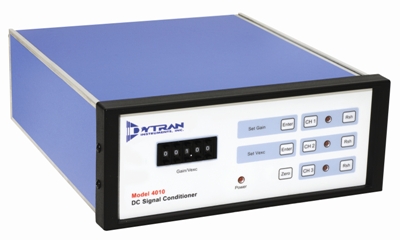Dytran Instruments, a manufacturer of DC MEMS and piezoelectric accelerometers, transducers and related electronics, has launched a latest model 4010 3-channel DC amplifier integrated with a microprocessor controller for signal conditioning, which can be employed along with either different or bridge type output acceleration sensors and pressure transducers in general purpose laboratory experimenting technologies.
 Dytran’s model 4010 Microprocessor Controlled DC Signal Conditioner Amplifier
Dytran’s model 4010 Microprocessor Controlled DC Signal Conditioner Amplifier
The model 4010 amplifier unit is capable of performing shunt calibrations, variable gain alteration and multiple settings of the excitation range.
The amplifier unit is operated in two different modes such as sleep and active modes. The high frequency clock noise and its related harmonics can be eliminated, when the microprocessor controlled amplifier unit works in sleep mode. When the front panel switch is turned on, the microprocessor switches to active mode for processing and executing the requested operation, after which it again changes to sleep mode. With this switching of modes upon request, the model 4010 DC signal conditioner amplifier can be enabled to provide clean, clock free signal output and generate less clock noise while operating.
The 3-channel microprocessor controlled DC amplifier is developed with two 12-bit data acquisition (DAC) unit for each channel, to automatically set its input and output values to zero for DC input signals. The input signals having magnitudes of about +/- 10 VDC can be set automatically to zero. The output signal’s zero can be trimmed within +/- mVDC using a distinct DAC trimming routine.
The transducer excitation deliveries for each of the amplifier’s channel are individually adjustable over a range from 0.00 VDC to 12.00 VDC. The amplifier will produce an excitation voltage of about 12.10 VDC, when the transducer excitation level is set to 12.00 VDC. The amplifier’s output signals are protected from short circuiting and are capable of supplying over 30 mA through each channel. Dytran’s amplifier unit is designed with a remote sensing leads, which ensures elimination of errors due to lengthy cables.